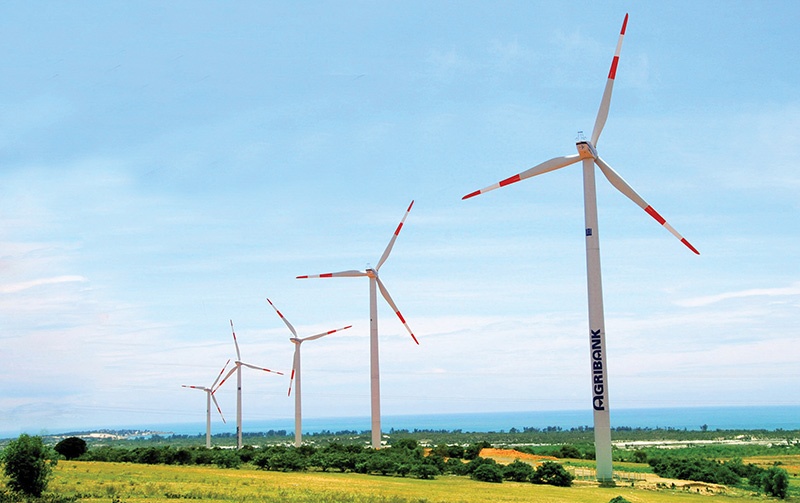Tackling power shortages in the northern region
 |
| The rise in use of wind power, as well as solar, means that general system management needs to be relooked and revamped to suit, photo Le Toan |
According to figures from Electricity of Vietnam (EVN), in 2022 the maximum power load capacity in the northern region could amount to 24,700MW, surging by up to 2,870MW compared to 2020.
The northern region would lack around 1,500-2,400MW in several peak hours, or face partial power shortage from May to July in the face of a protracted hot climate with temperatures often exceeding 36 degrees Celsius.
According to Do Nguyet Anh, chairwoman of Northern Power Corporation, the power supply in northern areas was already critical in 2021.
“The situation could linger on this year,” Anh said, citing that registered loads from the industrial sector’s corporate customers reached 3,400MW, up 24 per cent on-year, whereas power sources in the north have yet to increase.
Lack of viable plans to tackle hurdles associated with site clearance at a project on installing power lines connected to the Bac Giang power station and Lao Cai-Bao Thang line, developed by National Power Transmission Corporation, might further exaggerate power shortages compared to a year ago when production activities were at a standstill due to social and operational restrictions.
Meanwhile, the water volume flowing into hydropower dams dwindled in 2021 compared to previous years, while hydropower contributed more than 45 per cent of total power volume in northern areas. EVN estimates that by the end of 2021, the total water volume at hydropower dams equalled 14.3 billion kWh, down by 738 million kWh. The water volume kept at northern dams was slightly more than 7.46 billion kWh, resulting in a shortfall of 465 million kWh.
Coal-fired thermal power has also been fraught with difficulties. A sharp rise in imported coal prices has placed thermal power plants in a critical situation as the more they run, the lower the level of business efficiency. In recent weeks, several such plants have temporarily halted operations for maintenance while several others plan to run below full capacity in an attempt to save money.
At this time, the Thai Binh 2 thermal power plant is making big endeavours to be able to operate its two turbines with a combined capacity of 1,200MW by the end of the year, but 2023 is deemed more likely once the plant can ensure both technical and financial factors.
“Power shortages are mainly attributed to the prioritised use of power from renewable energy sources, with reduced mobilised volume from stable sources like hydro or thermal power,” commented Assoc. Prof. Dr. Nguyen Canh Nam from the Vietnam Energy Association.
In his words, a sharp jump in the rate of mobilised power from renewable sources, particularly from wind and solar power, causes difficulties for system management.
Currently, the total capacity from wind and solar power amounts to around 20,670MW, an increase of 3,420MW compared to 2020 and accounting for 27 per cent of the power system’s total installed capacity. At many times, the generation capacity from renewable sources reached 60 per cent.
Lower mobilised volume from traditional power sources has forced gas-fueled thermal power plants, including Phu My thermopower plant, to face operation stoppages on a daily basis.
Le Van Danh, general director of Power Generation Corporation 3, acknowledged there was a remarkable reduction in mobilised power volume from gas-fired power plants under their management.
As a result, consumed gas volume for power generation just approximated 4.67 billion cubic metres last year, equalling 65.59 per cent of EVN’s supply capacity. EVN however, has attributed power shortages in the northern region to tough weather conditions and still limited power transmission line systems.
The power demand for economic development is forecast to remain high in 2022. EVN has presented two power supply scenarios for the year: at the base scenario, power growth could fetch 8.2 per cent, equal to 275.5 billion kWh in national power output, while in the higher scenario, power growth fetches 12.4 per cent, equal to 286.1 billion kWh.
“The national power system will basically meet demand and serve economic development,” said Vo Quang Lam, EVN deputy general director at a conference on implementing related activities in mid-January.
In Lam’s words, hydropower dams, particularly those in the northern region, have now stored water to maximum limits since late 2021 to upscale plant capacity. EVN has also signed a contract appendix with smaller hydropower plants, adjusting suitable hours to best match power load demand.
“EVN has also increased studies into power storage system investment and the possibility of raising power import volume from Laos as well as considering load transmission from the central to the northern region,” said Lam, citing that the move would “contribute to curtailing power shortages during peak hours in the northern region.”
What the stars mean:
★ Poor ★ ★ Promising ★★★ Good ★★★★ Very good ★★★★★ Exceptional
Related Contents
Latest News
More News
- TCP Group partner with VNUS to launch water conservation project (December 25, 2025 | 14:00)
- Heavy industries set for pilot greenhouse gas quotas (December 25, 2025 | 10:00)
- Swedfund invests in MSME growth and climate action in Vietnam (December 19, 2025 | 11:42)
- GreenYellow brings solar energy to light up remote schools in Tuyen Quang province (December 19, 2025 | 08:00)
- Charge+, Grab partner to develop EV charging network in Vietnam (December 18, 2025 | 17:11)
- Linking sci-tech and innovation to Vietnam’s net-zero future (December 18, 2025 | 14:31)
- Driving double-digit growth through green and circular transformation in Vietnam (December 17, 2025 | 09:00)
- Standard Chartered and ACCA deepen collaboration to develop Vietnam’s talent for a sustainable future (December 15, 2025 | 18:18)
- Schaeffler reports strong early output from Dong Nai solar project (December 12, 2025 | 15:16)
- Forestry conference highlights biodiversity and sustainability goals (December 09, 2025 | 13:35)

 Tag:
Tag:





















 Mobile Version
Mobile Version